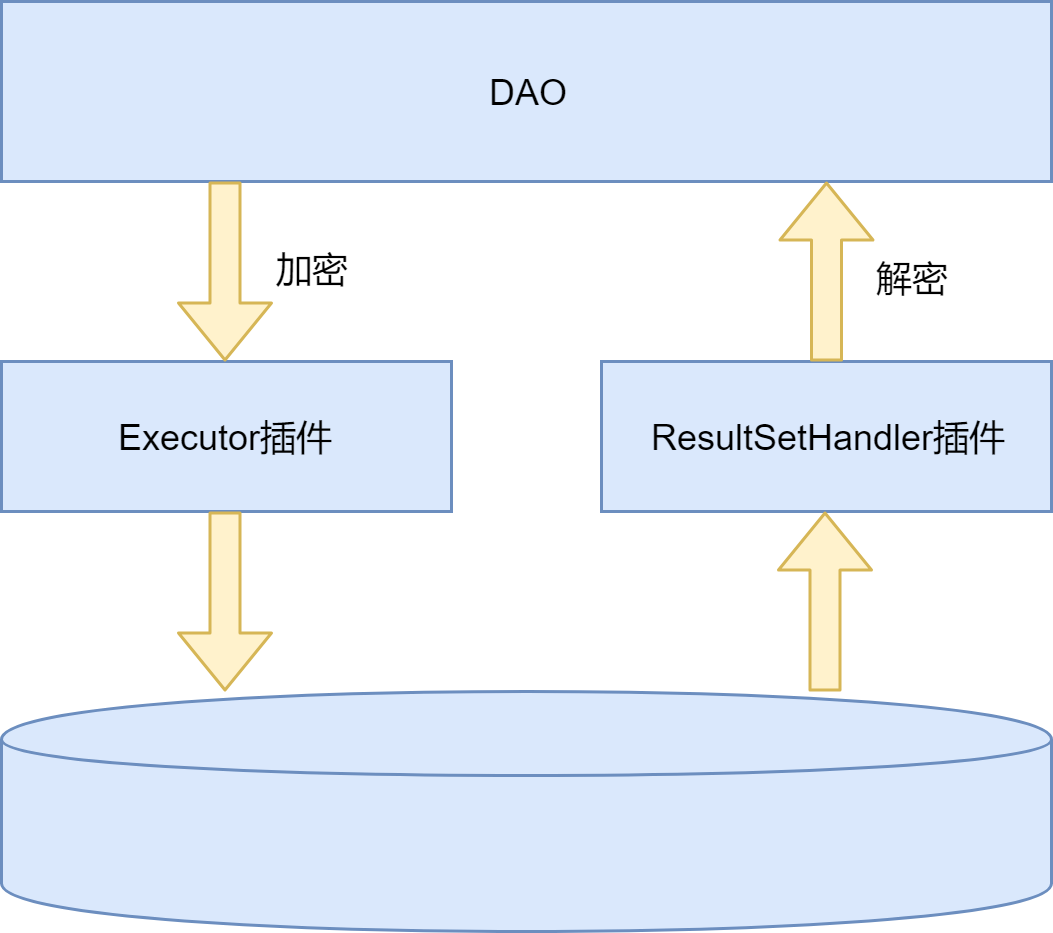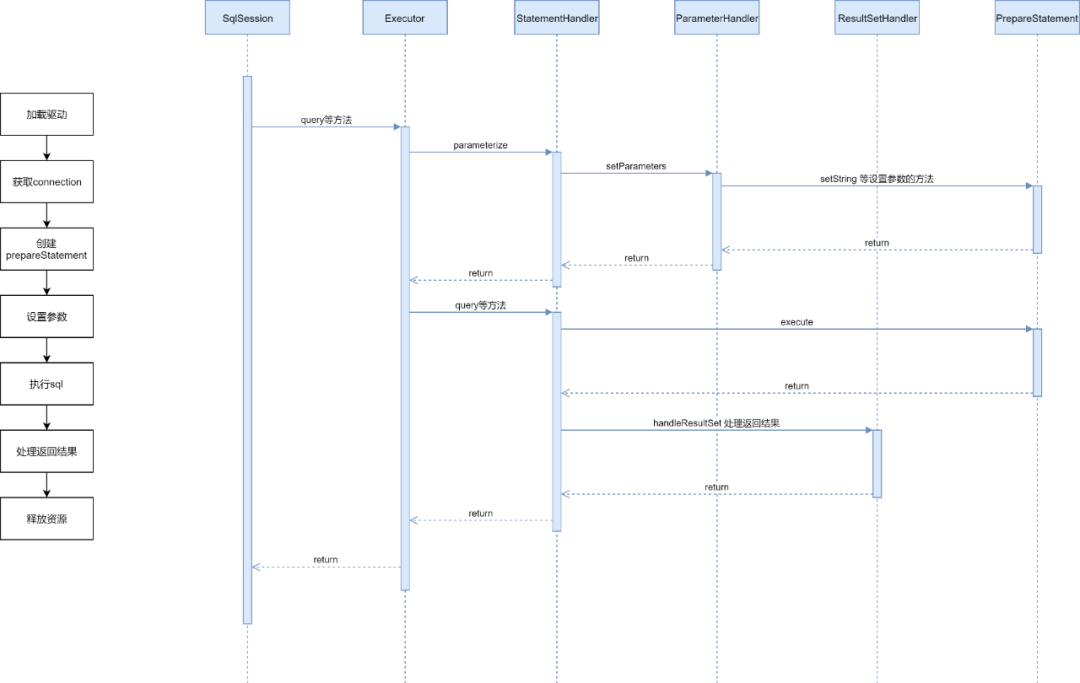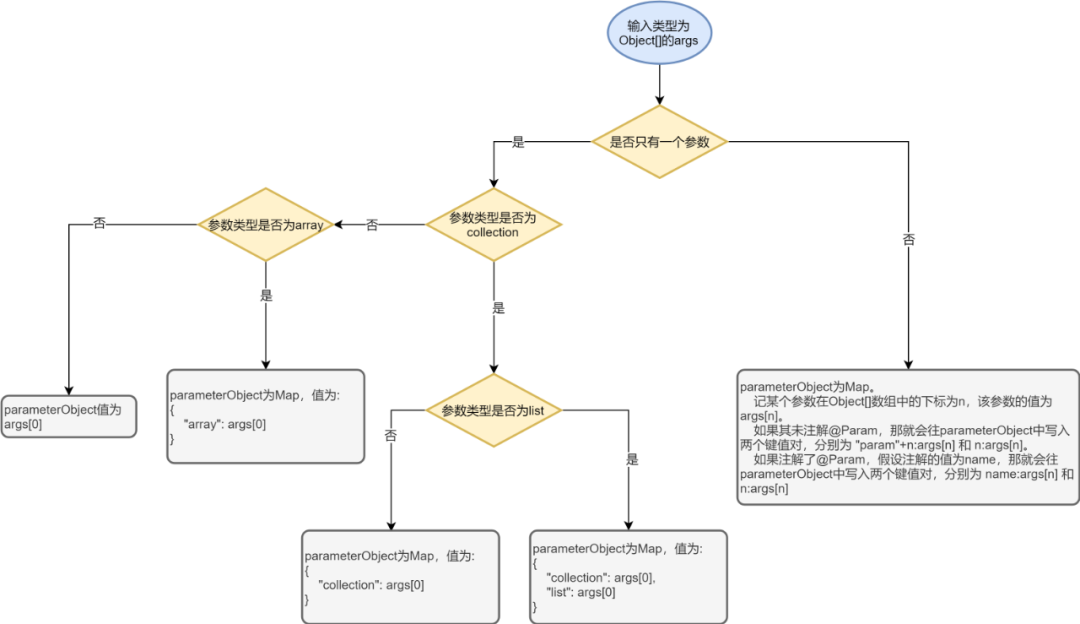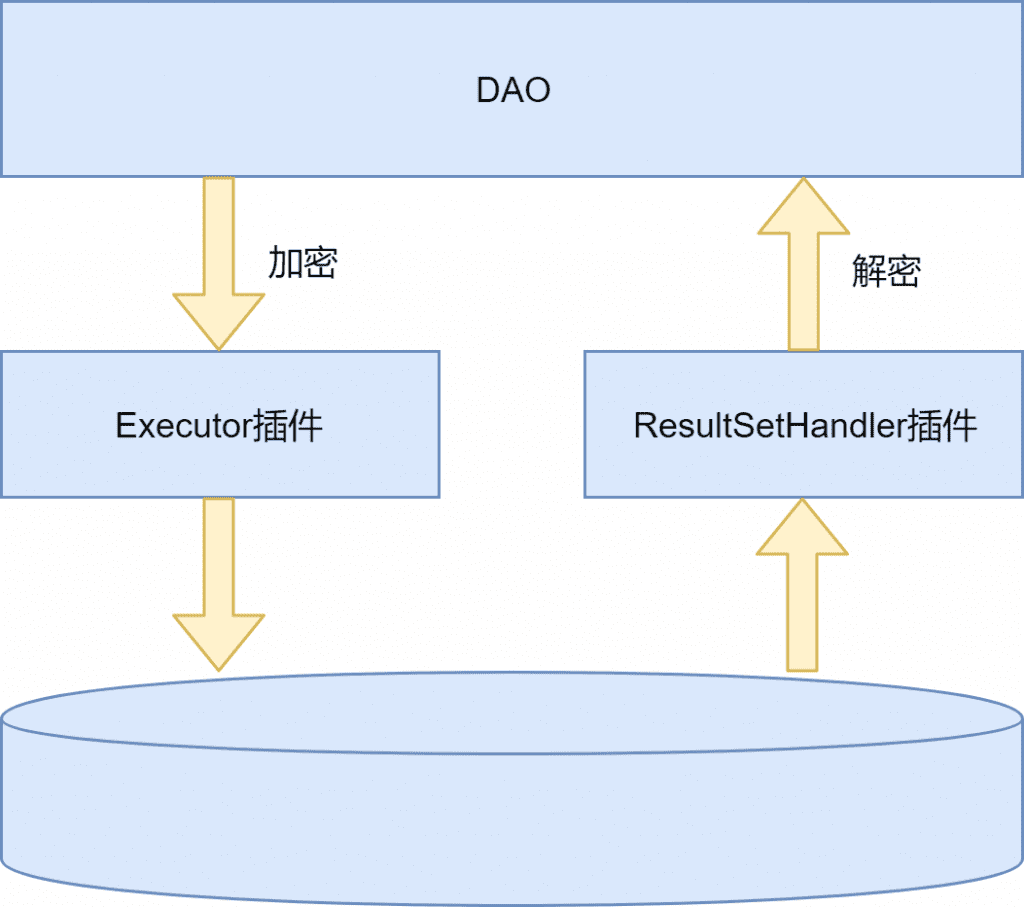vivo Internet Server Team – Li Gang
This article introduces the process of using the MyBatis plugin to implement database field encryption and decryption.
1. Background of demand
For security and compliance reasons, companies need to encrypt some fields stored in plaintext in the database to prevent unauthorized access and personal information leakage.
Since the project has stopped iterating and the cost of transformation is too high, we chose the MyBatis plugin to implement database encryption and decryption, to ensure that the specified fields can be encrypted when writing data to the database, and the specified fields can be decrypted when reading data.
2. Analysis of ideas
2.1 System Architecture

Add a ciphertext field for each field that needs to be encrypted (Intrusion into business), modify the database, mapper.xml and DO objects, and close the encryption and decryption of plaintext/ciphertext fields through plug-ins.
Custom Executor for SELECT/UPDATE/INSERT
The plaintext field of operations such as /DELETE is encrypted and set to the ciphertext field.
The custom plug-in ResultSetHandler is responsible for decrypting the query result, decrypting the ciphertext field of SELECT and other operations and setting it to the plaintext field.
2.2 System flow

A new decryption process control switch is added to control whether to write only the original field/double write/write only the encrypted field when writing, and whether to read the original field or the encrypted field when reading.
A new historical data encryption task is added, which encrypts historical data in batches and writes it to the encrypted field.
For security reasons, there will be some verification/compensation tasks in the process, which will not be repeated here.
3. Program formulation
3.1 Introduction to MyBatis plugin
MyBatis reserves org.apache.ibatis.plugin
.Interceptor interface, by implementing this interface, we canMyBatisThe execution process is intercepted, and the interface is defined as follows:
public interface Interceptor {Object intercept(Invocation invocation) throws Throwable;Object plugin(Object target);void setProperties(Properties properties);}
There are three methods:
【intercept】: The specific process of the plugin execution, the incoming Invocation isMyBatisEncapsulation of proxied methods.
【plugin】: Use the current Interceptor to create a proxy. The usual implementation is Plugin.wrap(target, this), and jdk is used to create a dynamic proxy object in the wrap method.
【setProperties】: Refer to the code below, inMyBatisWhen configuring the plugin in the configuration file, you can set parameters and call Properties.getProperty in the setProperties function
(“param1”) method to get the configured value.
<plugins><plugin interceptor="com.xx.xx.xxxInterceptor"><property name="param1" value="value1"/></plugin></plugins>
In implementing the intercept function pairMyBatisBefore intercepting the execution process, we need to use the @Intercepts annotation to specify the interception method.
@Intercepts({ @Signature(type = Executor.class, method = "update", args = { MappedStatement.class, Object.class }),@Signature(type = Executor.class, method = "query", args = { MappedStatement.class, Object.class, RowBounds.class, ResultHandler.class }) })
Referring to the above code, we can specify the classes and methods that need to be intercepted. Of course we can’t intercept arbitrary objects,MyBatisThe classes that can be intercepted are the following four.
Executor
StatementHandler
ParameterHandler
ResultSetHandler
Returning to the requirements of database encryption, we need to select the classes that can be used to implement entry encryption and exit decryption from the above four classes.Before introducing these four classes, it is necessary toMyBatishave a certain understanding of the execution process.
3.2 Spring-MyBatis execution process
(1) Spring creates sqlSessionFactory through sqlSessionFactoryBean. When using sqlSessionFactoryBean, we usually specify configLocation and mapperLocations to tell sqlSessionFactoryBean where to read the configuration file and where to read the mapper file.
(2) After getting the location of the configuration file and mapper file, call XmlConfigBuilder.parse() and XmlMapperBuilde respectively
r.parse() creates Configuration and MappedStatement. The Configuration class, as the name suggests, stores all the configurations of MyBatis, and the MappedStatement class stores eachSQLThe encapsulation of the statement, MappedStatement is stored in the Configuration object in the form of a map, and the key is the full path of the corresponding method.
(3) Spring scans all Mapper interfaces through ClassPathMapperScanner and creates BeanDefinition objects for them, but since they are essentially unimplemented interfaces, soSspringWill modify the beanClass property of their BeanDefinition to MapperFactorybean.
(4) MapperFactoryBean also implements the FactoryBean interface. Spring will call the FactoryBean.getObject() method to obtain the bean when creating a bean. Finally, a proxy is created for the mapper interface through the newInstance method of mapperProxyFactory. The proxy is created by JDK, and the final proxy is generated. The object is MapperProxy.
(5) All interfaces that call mapper essentially call the MapperProxy.invoke method, and internally call various methods such as insert/update/delete of sqlSession.
MapperMethod.javapublic Object execute(SqlSession sqlSession, Object[] args) {Object result;if (SqlCommandType.INSERT == command.getType()) {Object param = method.convertArgsToSqlCommandParam(args);result = rowCountResult(sqlSession.insert(command.getName(), param));} else if (SqlCommandType.UPDATE == command.getType()) {Object param = method.convertArgsToSqlCommandParam(args);result = rowCountResult(sqlSession.update(command.getName(), param));} else if (SqlCommandType.DELETE == command.getType()) {Object param = method.convertArgsToSqlCommandParam(args);result = rowCountResult(sqlSession.delete(command.getName(), param));} else if (SqlCommandType.SELECT == command.getType()) {if (method.returnsVoid() && method.hasResultHandler()) {executeWithResultHandler(sqlSession, args);result = null;} else if (method.returnsMany()) {result = executeForMany(sqlSession, args);} else if (method.returnsMap()) {result = executeForMap(sqlSession, args);} else {Object param = method.convertArgsToSqlCommandParam(args);result = sqlSession.selectOne(command.getName(), param);}} else if (SqlCommandType.FLUSH == command.getType()) {result = sqlSession.flushStatements();} else {throw new BindingException("Unknown execution method for: " + command.getName());}if (result == null && method.getReturnType().isPrimitive() && !method.returnsVoid()) {throw new BindingException("Mapper method '" + command.getName()+ " attempted to return null from a method with a primitive return type (" + method.getReturnType() + ").");}return result;}
(6) SqlSession can be understood as a session, SqlSession will obtain the corresponding MappedStatement from Configuration and hand it over to Executor for execution.
DefaultSqlSession.javapublic <E> List<E> selectList(String statement, Object parameter, RowBounds rowBounds) {try {MappedStatement ms = configuration.getMappedStatement(statement);return executor.query(ms, wrapCollection(parameter), rowBounds, Executor.NO_RESULT_HANDLER);} catch (Exception e) {throw ExceptionFactory.wrapException("Error querying database. Cause: " + e, e);} finally {ErrorContext.instance().reset();}}
(7) Executor will first create StatementHandler, which can be understood as a statement execution.
(8) Then the Executor will obtain the connection. The specific method of obtaining the connection depends on the implementation of the Datasource. The connection can be obtained by means of connection pooling.
(9) Then call the StatementHandler.prepare method, which corresponds to the Connection in the JDBC execution process
.prepareStatement this step.
(10) Executor then calls the parameterize method of StatementHandler to set the parameters, corresponding to
The StatementHandler.setXXX() of the JDBC execution process sets the parameters, and the ParameterHandler method is created internally.
SimpleExecutor.javapublic <E> List<E> doQuery(MappedStatement ms, Object parameter, RowBounds rowBounds, ResultHandler resultHandler, BoundSql boundSql) throws SQLException {Statement stmt = null;try {Configuration configuration = ms.getConfiguration();StatementHandler handler = configuration.newStatementHandler(wrapper, ms, parameter, rowBounds, resultHandler, boundSql);stmt = prepareStatement(handler, ms.getStatementLog());return handler.<E>query(stmt, resultHandler);} finally {closeStatement(stmt);}}
(11) The returned result is processed by ResultSetHandler, the return value of JDBC is processed, and it is converted into a Java object.
3.3 When to create the MyBatis plugin
In the Configuration class, we can see four methods: newExecutor, newStatementHandler, newParameterHandler, and newResultSetHandler. The proxy class of the plug-in is created in these four methods. I take the creation of StatementHandler as an example:
Configuration.javapublic StatementHandler newStatementHandler(Executor executor, MappedStatement mappedStatement, Object parameterObject, RowBounds rowBounds, ResultHandler resultHandler, BoundSql boundSql) {StatementHandler statementHandler = new RoutingStatementHandler(executor, mappedStatement, parameterObject, rowBounds, resultHandler, boundSql);statementHandler = (StatementHandler) interceptorChain.pluginAll(statementHandler);return statementHandler;}InterceptorChain.javapublic Object pluginAll(Object target) {for (Interceptor interceptor : interceptors) {target = interceptor.plugin(target);}return target;}
The interceptor.plugin corresponds to the method in the interceptor implemented by ourselves. The usual implementation is Plugin.wrap(target, this); . The method of creating a proxy internally is JDK.
3.4 MyBatis plugin can intercept class selection

Mybatis is essentially an encapsulation of the JDBC execution process. Combined with the above figure, we briefly summarize the functions of Mybatis, which can be delegated.
【Executor】: actually executeSQLThe object of the statement, when calling the method of sqlSession, is essentially the method of calling the executor, and is also responsible for obtaining the connection and creating the StatementHandler.
【StatementHandler】: Create and hold ParameterHandler and ResultSetHandler objects, operate JDBC statement and perform database operations.
【ParameterHandler】: Process the input parameters and set the parameters on the Java method to the executed statement.
【ResultSetHandler】: deal withSQLThe execution result of the statement, converting the return value to a Java object.
For the encryption of the input parameters, we need to change the parameter value to the encrypted parameter before the ParameterHandler calls the prepareStatement.setXXX() method to set the parameter, so it seems that intercepting Executor/StatementHandler/ParameterHandler can be done.
But actually? Since we are not encrypting the original field, but adding an encrypted field, what problems will this bring? Please see the dynamic SQL with encrypted fields in the mapper.xml file below:
<select id="selectUserList" resultMap="BaseResultMap" parameterType="com.xxx.internet.demo.entity.UserInfo">SELECT*FROM`t_user_info`<where><if test="phone != null">`phone` = #{phone}</if><if test="secret != null">AND `secret` = #{secret}</if><if test="secretCiper != null">AND `secret_ciper` = #{secretCiper}</if><if test="name">AND `name` = #{name}</if></where>ORDER BY `update_time` DESC</select>
It can be seen that this statement has a dynamic tag, it must not be directly handed over to JDBC to create prepareStatement, it needs to be parsed into static state firstSQLand this step is done before the Executor calls StatementHandler.parameterize(), and the MappedStatementHandler.getBoundSql(Object parameterObject) function parses the dynamic tags and generates staticSQLstatement, the parameterObject here can be regarded as a Map for the time being, and the key value is the parameter name and parameter value respectively.
Then let’s take a look at the problems with using StatementHandler and ParameterHandler for parameter encryption. When MappedStatementHandler.getBoundSql is executed, the encrypted parameters are not written in parameterObject. When judging the label, it must be no, and the final generated staticSQLIt must not contain encrypted fields. No matter how we deal with parameterObject in StatementHandler and ParameterHandler, the encryption of input parameters cannot be realized.
Therefore, in the encryption of input parameters, we can only choose to intercept the update and query methods of Executor.
What about decryption of the return value? Referring to the flow chart, we can intercept ResultSetHandler and Executor, which is indeed the case. In terms of processing return values, the two are equivalent. The return value of ResultSetHandler.handleResultSet() is directly passed to Executor, and then by Executor is transparently transmitted to SqlSession, so you can choose one of the two.
4. Implementation of the plan
After knowing the object to be intercepted, you can start to implement the encryption and decryption plug-in. First define a method dimension annotation.
@Target({ ElementType.METHOD })@Retention(RetentionPolicy.RUNTIME)@Inherited@Documentedpublic @interface TEncrypt {String[] srcKey() default {};String[] destKey() default {};}
Put this annotation on the DAO layer method that needs to be encrypted and decrypted.
UserMapper.javapublic interface UserMapper {(srcKey = {"secret"}, destKey = {"secretCiper"})List<UserInfo> selectUserList(UserInfo userInfo);}
Modify the xxxMapper.xml file
<mapper namespace="com.xxx.internet.demo.mapper.UserMapper"><resultMap id="BaseResultMap" type="com.xxx.internet.demo.entity.UserInfo"><id column="id" jdbcType="BIGINT" property="id" /><id column="phone" jdbcType="VARCHAR" property="phone"/><id column="secret" jdbcType="VARCHAR" property="secret"/><id column="secret_ciper" jdbcType="VARCHAR" property="secretCiper"/><id column="name" jdbcType="VARCHAR" property="name" /></resultMap><select id="selectUserList" resultMap="BaseResultMap" parameterType="com.xxx.internet.demo.entity.UserInfo">SELECT*FROM`t_user_info`<where><if test="phone != null">`phone` = #{phone}</if><if test="secret != null">AND `secret` = #{secret}</if><if test="secretCiper != null">AND `secret_ciper` = #{secretCiper}</if><if test="name">AND `name` = #{name}</if></where>ORDER BY `update_time` DESCv</select></mapper>
After making the above modifications, we can write the encryption plug-in
({ (type = Executor.class, method = "update", args = { MappedStatement.class, Object.class }),(type = Executor.class, method = "query", args = { MappedStatement.class, Object.class, RowBounds.class, ResultHandler.class }) })public class ExecutorEncryptInterceptor implements Interceptor {private static final ObjectFactory DEFAULT_OBJECT_FACTORY = new DefaultObjectFactory();private static final ObjectWrapperFactory DEFAULT_OBJECT_WRAPPER_FACTORY = new DefaultObjectWrapperFactory();private static final ReflectorFactory REFLECTOR_FACTORY = new DefaultReflectorFactory();private static final List<String> COLLECTION_NAME = Arrays.asList("list");private static final String COUNT_SUFFIX = "_COUNT";public Object intercept(Invocation invocation) throws Throwable {final Object[] args = invocation.getArgs();MappedStatement mappedStatement = (MappedStatement) args[0];Object parameterObject = args[1];String id = mappedStatement.getId();String className = id.substring(0, id.lastIndexOf("."));String methodName = id.substring(id.lastIndexOf(".") + 1);if (methodName.endsWith(COUNT_SUFFIX)) {methodName = methodName.substring(0, methodName.lastIndexOf(COUNT_SUFFIX));}final Method[] methods = Class.forName(className).getMethods();for (Method method : methods) {if (method.getName().equalsIgnoreCase(methodName) && method.isAnnotationPresent(TEncrypt.class)) {TEncrypt paramAnnotation = method.getAnnotation(TEncrypt.class);if (parameterObject instanceof Map) {List<String> paramAnnotations = findParams(method);parameterMapHandler((Map) parameterObject, paramAnnotation, mappedStatement.getSqlCommandType(), paramAnnotations);} else {encryptParam(parameterObject, paramAnnotation, mappedStatement.getSqlCommandType());}}}return invocation.proceed();}}
The main process of encryption is as follows:
Determine whether the method called this time is annotated with @TEncrypt.
Get the annotation and the parameters configured on the annotation.
Traverse the parameterObject to find the fields that need to be encrypted.
Call the encryption method to get the encrypted value.
Write encrypted fields and values to parameterObject.
The difficulty is mainly in the parsing of parameterObject. At the Executor level, parameterObject is no longer a simple Object.[]but by MapperMethod
.convertArgsToSqlCommandParam(Object[] args) method to create an object, since we want to deal with this object, we must first know its creation process.

Referring to the creation process of the parameterObject in the figure above, the processing of the parameterObject by the encryption plug-in is essentially a reverse process. If it is a list, we traverse each value in the list, and if it is a map, we traverse each value in the map.
After obtaining the Object to be processed, traverse each attribute in the Object to determine whether it is in the srcKeys parameter of the @TEncrypt annotation. If so, encrypt it and set it to the Object.
The logic of the decryption plug-in is basically the same as that of the encryption plug-in, and will not be repeated here.
V. Challenges
5.1 The paging plugin automatically generates the count statement
Many places in the business code use com.github.pagehelper for physical paging. Refer to the demo below. When using PageRowBounds, the pagehelper plugin will help us get the total number of eligible data and set it to the total property of the rowBounds object.
PageRowBounds rowBounds = new PageRowBounds(0, 10);List<User> list = userMapper.selectIf(1, rowBounds);long total = rowBounds.getTotal();
Then the problem comes, on the surface, we only execute the statement userMapper.selectIf(1, rowBounds), and pagehelper is rewritten by rewritingSQLThe physical paging implemented by increasing limit and offset does not read all the qualified data from the database during the execution of the entire statement, so how does pagehelper get the total number of data?
The answer is that pagehelper will execute one more count statement. Let’s not talk about the principle of executing an additional count statement, let’s first see what problems can be caused by adding a count statement.
Referring to the previous selectUserList interface, suppose we want to select data whose secret is a certain value, then the final execution after processing by the encryption plugin is roughly the following statement “select * from t_user_info where secret_ciper = ? order by update_time limit ?, ?” .
However, since pagehelper will execute another statement, and since the statement does not have the @TEncrypt annotation, it will not be intercepted by the encryption plugin. The final executed count statement is similar to this: “select count
from t_user_info where secret = ? order by update_time”.
It can be clearly seen that the first statement uses secret_ciper as the query condition, and the count statement uses secret as the query condition, which will cause the final amount of data to be inconsistent with the actual amount of data.
Therefore, we have specially treated the count statement in the code of the encryption plug-in. Since the id of the mappedStatement corresponding to the count statement added by the pagehelper is fixed at the end of “_COUNT”, and this id is the full path of the method in the corresponding mapper, for example Let’s say the id of the original statement is “com.xxx.internet.demo.entity
.UserInfo.selectUserList”, then the id of the count statement is “com.xxx.internet.demo.entity.UserInfo.selectUserList_COUNT”, after removing “_COUNT”, we can judge whether there are annotations on the corresponding method.
6. Summary
This article introduces the exploration process of using the MyBatis plug-in to implement database field encryption and decryption. There are many details that need to be paid attention to in the actual development process, and my understanding of MyBatis has deepened throughout the process. In general, this solution is relatively lightweight, and although it is intrusive to business code, it can control the impact to a minimum.
END
you may also like
This article is shared from the WeChat public account – vivo Internet Technology (vivoVMIC).
If there is any infringement, please contact support@oschina.cn to delete it.
This article participates in the “OSC Yuanchuang Program”, and you are welcome to join and share with us.
#Implement #MyBatis #encryption #decryption #plugin #scratch #vivo #Internet #Technology #News Fast Delivery
Implement a MyBatis encryption and decryption plug-in from scratch – vivo Internet Technology – News Fast Delivery
